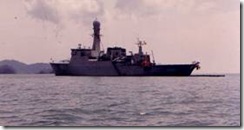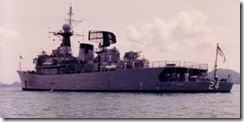I took my wife Josephine and son Ian to the air show held at Pulau Langkawi from the 7th of December to the 12th December. It was my first visit and the main venue was at the International airport itself at Padang Matsirat.
Lima means Langkawi International Maritime and Aerospace. It was the show case into advance technology and sophistication of the Aviation and Naval hardware. It was the greatest show ever to be staged in this region besides the Asian Aerospace in Singapore.
The top aerospace and the naval defence manufacturers are eyeing for their share of Asia and South East Asia market.
The Russian made a significant presence with their 4 jet-engine Antonov-124 strategic air-lifter the mighty “Ruslan” (NATO code name Condor). The gigantic aircraft had a maximum payload of 150 metric tons and 24 wheels undercarriage to support the massive weight. First flown in December 1982 and entered service with the Soviet air forces in 1987. It could be opened from the front with up-ward hinging “visor-type” nose and for easy loading the nose-wheel could be retracted to allow the nose-down positioning. The interior revealed a large cargo hold with titanium flooring capable of loading virtually anything from tanks, helicopters, aircraft to other military stores. It had a wingspan of 240 ft, length of 226 ft and the height of 69 ft. For performance it had maximum cruising speed of 537 mph and the altitude of 39,380 ft. It had upper cabin after the wings for 88 passengers and 350 troopers on the lower deck.
The Russian monster Antonov AN-124 “Ruslan” heavy lifter
The two giant AN-124’s brought in 4 Mikonyan-Gurevich designed super fighters the MIG-29 (NATO code Fulcrum) an incredibly agile and capable supersonic interceptor. First flown in 1977 had a wingspan of 37 ft 3 ins, length of 48 ft. 9 ins. and height of 15 ft 6 ins with speed Mach 2 that is twice the speed of sound. They were built in substantial numbers equipping the Russian Air Force, Eastern block countries and exported to their allies China and India. Ukraine besides Russia was a major operator of the MIG-29 and had an aerobatic team called the “Russian Knights”. Other aircraft was MIG-31 (NATO code Fox hound) and Sukhoi SU-27 (NATO code Flanker) supersonic interceptors. There were also two helicopters.
The Russian MIG 31 super fighter MIG-29 aerobatic team
Also came a big three jet engine type Tupolev T-154 airliner displaying the logo of their national carrier “Aeroflot” Last and not least the tiny “Baby Mig” a single seat ultra-light Aviatika built type 890; the 890-U was a dual-seat version. I was more interested in this tiny ultra-light rather than the huge fighter. That was something that I could fly and may even have the opportunity when they are brought into the country. One Aviatika 890-U dual seat side-by-side model was presented to the Prime Minister as a token of good will. Solidly built to Russian requirements this Ultra-light can withstand rough handling.
It appeared that the Russian were in a serious business mood and were there to draw interest from the ministers, the military leaders from the Asian countries. It was their chance to demonstrate their product superiority over or at least equivalent to western standard. Their aerobatic team was a thriller as it went through various maneuvers loops, rolls and spirals. It was obvious that they also wanted to be included as a strong competitor in the defence market. It was a good exposure to the International Press and the Media on what they had in store unseen in this part of the World.
In one scenario trailing colourful smoke vapors of red, white and blue the world renowned British aerobatic team the “Red Arrows” burst into the sky above in a fantastic display of aerial maneuvers that thrilled the huge crowd. All eyes were glued on the formation of British built BAE Hawk jet aircraft painted red as they went through their stunts. They loops, rolls, converging head-on and criss-crossed each other what seems to be dangerously close. It drew the excitement of the crowd and to their hair-raising stunt.
The Royal Malaysian Air Force also had their own aerobatic teams made up of a 7-ship formation aircraft type Northrop F-5E Tigers called “Kris Mas”. Another a 4-ship formation team called “Cakera Mada” flying the old MacDonald Douglas A-4 Sky Hawks and the “Taming Sari” flying propeller driven newly acquired Swiss-built Pilatus PC-7 trainers.
Another classic performance was by a single F-18 “Hornet” of No.75 squadron the Royal Australian Air Force. The powerful twin-engine jet shot into the sky in a tremendous display of skill, daringness and thrilled the whole crowd.
I was particularly drawn to the flying display by the Ultra-light “Aviatika 890” a multi-
purpose ultra-light that could be employed as a trainer, spotter, air patrol or aerial photography. It is the product of MAPO the same factory that makes the big MIG fighters. The power-plant a 64 hp “Rotax 582”engine is from Austria... It had a wingspan of 26 ft 6 ins, length of 17 ft 4 ins and empty weight of 451 lbs. Maximum speed at level flight 75.6 knots. The flight endurance is about 3.5 hours.
In the cockpit of the single-seat Aviatika 890
It was my first visit to Pulau Langkawi a beautiful island paradise, smaller than Singapore and situated at the North Western part of Malaya near to southern tip of Thailand. The island covers some 52,618 hectares mostly forested by tropical jungle. The highest point on the island is Mount Raya about 869 m above sea level. The population numbering some 40,000 is largely concentrated around the main town of Kuah.
We stayed at a wonderful beach resort of “Pelangi” located at the Pantai Cenang comprising of a cluster of low two storied wooden buildings in beautiful landscape setting. It is fringed by coconut palm, shrubs, ferns and link by walk-ways creating a homely atmosphere; kampong style. The swimming pool had excellent facilities with a bar by the edge, serving customers seated on the stool in the water.
We took time to pay a visit to the tomb of the legendary figure of Mahsuri. The beautiful maiden was wrongfully accused of adultery and subsequently put to death. It was said that during the execution white blood flowed out instead of the usual red. That was firm testimony of her innocence but before her death she laid a curse on the island for 7 generations. The place was destroyed by external enemies thus fulfilling the curse that only castor trees could grow and doves could live there, Generally people still came to pay homage and to pray at her tomb; anyway it has become a tourist attraction.
Josephine at the tomb of Mahsuri
Author with son at Pelangi resort poolside bar
After some days we took a boat out to sea off Tanjong Mali where the anchorage was located for the naval review. Unfortunately most of the ships had already sailed off, however we managed to take some photos of the remaining warships. A British Royal Navy 4,100 tons destroyer type 42 name HMS “ Glasgow” and pennant No.(D 88)
HMS Glasgow Sagitario
Two Italian frigates of 2,525 tons of the “Lupo” class name and pennant numbers “Sagitario” ( F 565) and ? (F 552)
Vaederen (F 359) KD Rahmat (F 24)
A 3,500 tons frigate from Denmark name “Vaederen” with pennant no. ( F 359) and
lastly a Royal Malaysian Navy frigate name KD “Rahmat” with pennant no. (F 24)
All the naval ships had flight deck at the stern to accommodate a helicopter for offensive role, maritime patrolling and anti-submarine work.
We had a hectic day in the hot sun cruising about a small boat along a line of warships at anchor, looking and a admiring the machines of war at sea. At the end of the day we were really glad to be back to our hotel for refreshing up and ready for our meals. After that we watch TV or just relaxing in a cozy corner before retiring to bed.













